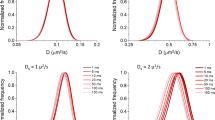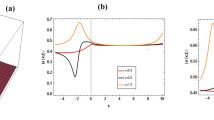Abstract
Temporal changes in association anddissociation kinetics of the repressor –operator reaction were simulated by a computational approach using MATOLABO on the basis of strict mathematical description. The diffusion equation of a repressor particle has been combinedwith arrival probabilities of therepressor particle. Temporal behaviors of the repressor operator complex have been computed by inverting the Laplace transformed equations. The temporal kinetic data of association anddissociation obtained at differentionic strength and at different DNA length were successfully simulated. Those results could be achieved byregulating diffusion constants inmedium on the DNA, a reaction radius of the repressor and a reaction rate per one repressor on the reaction sphere surface, k value. The reported values of association rate constant ka obtained at different ionic strength were also successfully simulated. Amongthe regulated parameters to get these successful simulations, the reaction rate per one particle on the reaction sphere surface, k value has effectiveinfluences on the association anddissociation kinetics particularly those at varying ionic strength that were induced by high KCl condition. By an electro chemical consideration for thechange of k value in combinationwith the screening effects of counter ions around the repressor particle and the DNA molecule, the most effectivefactor seems to be the Coulombrepulsive forces and or Londondispersion forces. The sliding mechanism for facilitated translocation of a repressor protein ona DNA chain can be described by the present mathematical approach which describes the temporal changes in amounts of the species. To achieve such mechanism in varying ionic strength,the secondary changes in the diffusion constants, the reaction radius and the reaction rate per one particle on thereaction sphere surface k value (anelectro chemical factor) seemed to have important roles.
Similar content being viewed by others
References
Von Hippel, P.H.: On the Molecular Bases of the Specificity of Interaction of Transcriptional, Proteins with Genome DNA, In: R.F. Goldberger (eds.), it Biological Regulation and Development, Plenum Press, NY, 1979, 8, pp. 279–347.
Von Hippel, P.H. and Berg, O.G.: Facilitated Target Location in Biological Systems, J. Biol. Chem. 264(2) (1989), 675–678.
Berg, O.G., Winter, R.B. and von Hippel, P.H.: Diffusion-Driven Mechanisms of Protein Translation on Nucleic Acid. 1. Model and Theory, Biochemistry 20 (1981), 6929–6948.
Riggs, A.D., Bourgeois, S. and Cohn, M.: The lac Repressor-Operator Interaction. III. Kinetic Studies, J. Mol. Biol. 53 (1970), 401–417.
Richter, P.H. and Eigen, M.: Diffusion Controlled Reaction Rates in Spheroidal Geometry. Application to Repressor-Operator Association and Membrane Bound Enzymes, Biophys. Chem. 2 (1974), 255–263.
Berg, O. and Blomberg, C.: Association Kinetics with Coupled Diffusional Flows, Biophys. Chemi. 4 (1976), 367–381.
Winter, R.B.: Equilibrium and Kinetic Studies of the lac Repressor-Operator Interaction. A Dissertation, Dept. of Chemistry and the Graduate School of the University of Oregon, December 1980.
Winter, R.B. and von Hippel, P.H.: Diffusion-Driven Mechanisms of Protein Translation on Nucleic Acid. 2. The Escherichica coli Repressor-Operator Interaction; Equilibrium Measurements, Biochemistry 20 (1981), 6948–6960.
Winter, R.B., Berg, O.G. and von Hippel, P.H.: Diffusion-Driven Mechanisms of Protein Translation on Nucleic Acid. 3. The Escherichica coli Repressor-Operator Interaction; Kinetic Measurements and Conclusions, Biochemistry 20 (1981), 6961–6977.
Collins, F.C. and Kimball, G.E.: Diffusion Controlled Reaction Rates, J. Colloid. Sci. 4 (1949), 425–437.
Carslaw, H.S. and Jaeger, J.C.: Conduction of Heat in Solids, Oxford Univ. Press, London, 1967.
Hirayama, H.: Transient Analysis of Stochastic Process in Gene Regulation', Proc. 31st Int. Symp. on Stochastic Systems Theory and its Application, pp. 283–288, 1999.
Stechfest, H.: Numerical Inversion of Laplace transforms, Comm. ACM. 13 (1970), 47–49.
Stigter, D.: Interactions of Highly Charged Colloidal Cylinders with Application to Double-Stranded DNA, Biopolymers 16 (1977), 1435–1448.
Record, M.T. Jr., Anderson, C.F. and Lohman, T.M.: Thermodynamical Analysis of Ion Effects on the Binding and Conformational Equilibria of Proteins and Nucleic Acids; The Roles of Ion Association or Release Screening and Ion Effects on Water Activity, Q. Rev. Biophys. 72 (1978), 103–178.
Berry, R.S., Rice, S.A. and Ross, J.: Physical Chemistry, Intermolecular forces. Oxford University Press, 2000, 10, pp. 298–312.
Booth, F.: The Cataphoresis of Spherical, Solid Non Conducting Particles in a Symmetrical Electrolyte, Proc. Roy. Soc A 203 (1950), 514–.
Mangelsdorf, C.S. and White, L.R.: Effects of Stern-Layer Conductance on Electrokinetic Transport Properties of Colloidal Particles, J. Chem. Soc. Faraday. Trans. 86(16) (1990), 2859–2870.
Hirayama, H.: Computational Dynamical Method for Evaluating the Mobility of Charged Bio molecules Passing Through the Electrical Potential Field within the Ion Selective Channel on Excitable Membrane, Technical report of Institute of Electronics, Information and Communication Engineers, OME 2002-66-78. 2002, pp. 55–60.
Schurr, J.M.: The One-Dimensional Diffusion Coefficient of Protein Absorbed on DNA, Biophys. Chem. 9 (1979), 413–414.
Lin, S. and Riggs, A.D.: The General Affinity of lac Repressor for E. Coli DNA, Cell 4 (1975), 107–1111.
Berg, O.G. and Blomberg, C.: Association Kinetics with Coupled Diffusion III. Ionic Strength Dependence of the Lac Repressor-Operator Association, Biophys. Chem. 8 (1978), 271–280.
Israelachvill, J.N.: Intermolecular and Surface Forces, Academic press, 1992.
Author information
Authors and Affiliations
Rights and permissions
About this article
Cite this article
Hirayama, H., Okita, O. Computation of Diffusion Limited Controlled Actions for Gene Regulating Repressor Particles. Journal of Biological Physics 30, 1–31 (2004). https://doi.org/10.1023/B:JOBP.0000016448.26081.01
Issue Date:
DOI: https://doi.org/10.1023/B:JOBP.0000016448.26081.01




